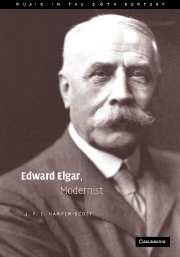Book contents
- Frontmatter
- Contents
- Preface
- 1 Styles and ideas
- 2 A Heideggerian refinement of Schenker's theory
- 3 Immuring and immured tonalities: tonal malaise in the First Symphony, Op. 55
- 4 ‘Fracted and corroborate’: narrative implications of form and tonality in Falstaff, Op. 68
- 5 Hermeneutics and mimesis
- 6 The annihilation of hope and the unpicking of identity: Elgarian hermeneutics
- 7 Modern music, modern man
- Glossary
- Bibliography
- Index
7 - Modern music, modern man
Published online by Cambridge University Press: 03 May 2010
- Frontmatter
- Contents
- Preface
- 1 Styles and ideas
- 2 A Heideggerian refinement of Schenker's theory
- 3 Immuring and immured tonalities: tonal malaise in the First Symphony, Op. 55
- 4 ‘Fracted and corroborate’: narrative implications of form and tonality in Falstaff, Op. 68
- 5 Hermeneutics and mimesis
- 6 The annihilation of hope and the unpicking of identity: Elgarian hermeneutics
- 7 Modern music, modern man
- Glossary
- Bibliography
- Index
Summary
It is because Elgar's symphonic narrative style, which my emphasis on the Augenblick brings into focus, is so contra-Beethovenian that total reliance on the Ursatz as a structural prop simply will not suffice. We can ask again the questions at the beginning of this book: is early modernist syntax basically Beethovenian–Schenkerian, and is Schenkerian analysis of it appropriate? Clearly there are vital elements of the common-practice syntax in Elgar, for instance his contrapuntal prolongation of diatonic triads and the dramatic opposition of subsidiary keys; but the syntax is taken to extremes that make an orthodox Schenkerian reading inadequate. First, contrapuntal prolongation will very often be off the triad rather than on it, either before or after an arrival: so, for instance, in the first-movement exposition of the First Symphony, the triad of A minor is prolonged first by a VI–V–i cadence, where VI is itself established so painstakingly that it almost sounds like a tonic, then in the development V/a is prolonged contrapuntally. A minor itself, however, only appears for a very short while (11:4 and 17:1). It is the movement towards and then sharply away from a goal that takes up all Elgar's time. Since in the pristinely cynical world all possibilities are equally undesirable, the only acceptable option is to procrastinate, which is precisely what he does. Second, in Elgar's immuring–immured tonal structure the opposed key is prolonged to such great lengths, and with its own subsidiary keys and Ursatz, that it becomes a tonality itself.
- Type
- Chapter
- Information
- Edward Elgar, Modernist , pp. 220 - 230Publisher: Cambridge University PressPrint publication year: 2006

